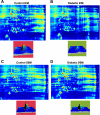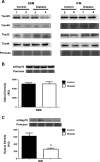Proteomic alterations of distinct mitochondrial subpopulations in the type 1 diabetic heart: contribution of protein import dysfunction
- PMID: 21048079
- PMCID: PMC3043804
- DOI: 10.1152/ajpregu.00423.2010
Proteomic alterations of distinct mitochondrial subpopulations in the type 1 diabetic heart: contribution of protein import dysfunction
Abstract
Diabetic cardiomyopathy is associated with increased risk of heart failure in type 1 diabetic patients. Mitochondrial dysfunction is suggested as an underlying contributor to diabetic cardiomyopathy. Cardiac mitochondria are characterized by subcellular spatial locale, including mitochondria located beneath the sarcolemma, subsarcolemmal mitochondria (SSM), and mitochondria situated between the myofibrils, interfibrillar mitochondria (IFM). The goal of this study was to determine whether type 1 diabetic insult in the heart influences proteomic make-up of spatially distinct mitochondrial subpopulations and to evaluate the role of nuclear encoded mitochondrial protein import. Utilizing multiple proteomic approaches (iTRAQ and two-dimensional-differential in-gel electrophoresis), IFM proteomic make-up was impacted by type 1 diabetes mellitus to a greater extent than SSM, as evidenced by decreased abundance of fatty acid oxidation and electron transport chain proteins. Mitochondrial phosphate carrier and adenine nucleotide translocator, as well as inner membrane translocases, were decreased in the diabetic IFM (P < 0.05 for both). Mitofilin, a protein involved in cristae morphology, was diminished in the diabetic IFM (P < 0.05). Posttranslational modifications, including oxidations and deamidations, were most prevalent in the diabetic IFM. Mitochondrial heat shock protein 70 (mtHsp70) was significantly decreased in diabetic IFM (P < 0.05). Mitochondrial protein import was decreased in the diabetic IFM with no change in the diabetic SSM (P < 0.05). Taken together, these results indicate that mitochondrial proteomic alterations in the type 1 diabetic heart are more pronounced in the IFM. Further, proteomic alterations are associated with nuclear encoded mitochondrial protein import dysfunction and loss of an essential mitochondrial protein import constituent, mtHsp70, implicating this process in the pathogenesis of the diabetic heart.
Figures






Comment in
-
A needle in a haystack: focus on "Proteomic alterations of distinct mitochondrial subpopulations in the type 1 diabetic heart".Am J Physiol Regul Integr Comp Physiol. 2011 Feb;300(2):R183-5. doi: 10.1152/ajpregu.00751.2010. Epub 2010 Dec 1. Am J Physiol Regul Integr Comp Physiol. 2011. PMID: 21123761 No abstract available.
References
-
- Artal-Sanz M, Tavernarakis N. Prohibitin and mitochondrial biology. Trends Endocrinol Metab 20: 394–401, 2009 - PubMed
-
- Baynes JW. Role of oxidative stress in development of complications in diabetes. Diabetes 40: 405–412, 1991 - PubMed
-
- Bradford MM. A rapid and sensitive method for the quantitation of microgram quantities of protein utilizing the principle of protein-dye binding. Anal Biochem 72: 248–254, 1976 - PubMed
-
- Bugger H, Boudina S, Hu XX, Tuinei J, Zaha VG, Theobald HA, Yun UJ, McQueen AP, Wayment B, Litwin SE, Abel ED. Type 1 diabetic akita mouse hearts are insulin sensitive but manifest structurally abnormal mitochondria that remain coupled despite increased uncoupling protein 3. Diabetes 57: 2924–2932, 2008 - PMC - PubMed
Publication types
MeSH terms
Substances
Grants and funding
LinkOut - more resources
Full Text Sources
Other Literature Sources
Medical

